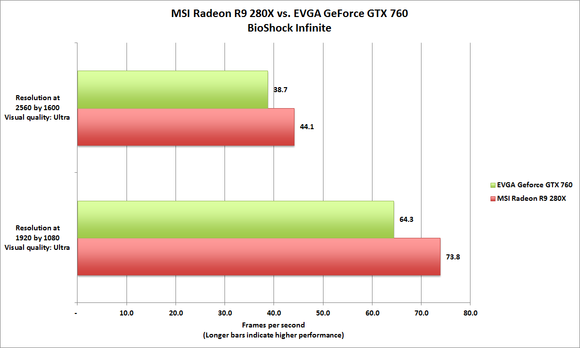AMD has scored big with the gaming-console builders, earning design wins with Microsoft (the Xbox One), Sony (the PlayStation 4), and Nintendo (the Wii U). Now the company is turning its attention back to PC gaming with the launch of its R7 and R9 graphics processor families.
But AMD has a funny definition of "family," because some of the new GPUs the company recently announced, including the Radeon R9 280X reviewed here, aren't entirely new: They're tweaked versions of earlier products.
AMD objects to me classifying them as "rebadged" because that describes an old product that's merely dressed up with a new name. In this case, AMD's engineers took last year's Radeon HD 7970 GHz Edition, tweaked its specs, and added some new features before slapping a new label on it. But a company spokesperson has confirmed that the Radeon R9 280X "share[s] the same ASIC" as the Radeon HD 7970GHz Edition (ASIC is an acronym for application-specific integrated circuit).
 The Radeon R9 280X lets you turn up all the details in BioShock Infinite—on a 30-inch display, no less.
The Radeon R9 280X lets you turn up all the details in BioShock Infinite—on a 30-inch display, no less. AMD's marketing shenanigans put boutique PC-builder Origin Computer's very public breakup in a whole new light, but don't let that dissuade you from considering a video card based on this—ahem—new GPU. Based on MSI's implementation, the Radeon R9 280X OC Edition, I'd say AMD is bringing high-resolution gaming to the masses—or at least the moderately well-heeled masses. A Radeon HD 7970 GHz Edition card cost $500 when we reviewed it in June 2012, and SKUs based on that GPU were selling for around $385 the day before this launch. MSI's card is faster, it delivers several features that aren't possible with the old GPU, and it's priced at just $299.
As with the older GPU, the Radeon R9 280X processor consists of 2048 graphics cores paired with 3GB of GDDR5 memory linked by an interface that's 384 bits wide. MSI departs from AMD's reference design by mounting its Twin Frozr IV dual fan and heatsink over the GPU and memory, and it gooses the GPU's clock by a modest 50MHz, running it at 1050MHz compared to the reference design's 1000MHz. MSI didn't push the memory's clock speed at all: It runs at a stock 1500MHz.
 Fancy some Lara Croft action? The Radeon R9 280 delivers.
Fancy some Lara Croft action? The Radeon R9 280 delivers. You'll need one x16 PCIe slot to install this card, and it will take up two of the slots on the back of your PC. That's pretty common for higher-end cards (some over-the-top designs require three). You'll need a minimum of a 500-watt power supply, with one 6-pin and one 8-pin power connector to run a single R9 280x. Double those specs to run two of them in CrossFire.
 DiRT Showdown performance is certainly no exception to the performance pattern.
DiRT Showdown performance is certainly no exception to the performance pattern. MSI provides two mini DisplayPort connectors, one HDMI, and one DVI-I on the card's mounting bracket (AMD's reference design provides one full-size DisplayPort, HDMI, and dual DVI ports). Either configuration makes it easy to connect multiple displays, although it's a pity that so few consumer displays feature DisplayPort connections.
Speaking of DisplayPort, older GPUs depend on it to deliver AMD's EyeFinity multi-monitor technology. With those cards, you can connect a maximum of two HDMI or DVI displays, but the rest must be DisplayPort (or active DisplayPort adapters). GPUs in the Radeon R9 family support up to three HDMI or DVI displays, and you can add up to three more (using DisplayPort) to rock six monitors in all. There are some stipulations: All the displays must support identical timings, and the display clocks and timing must be configured at boot time—hot-plugging is not supported.
 AMD's new GPU performs well with artificial benchmarks, too.
AMD's new GPU performs well with artificial benchmarks, too. The Radeon R9 280X also supports AMD's Project Mantle API (application program interface) initiative, which promises game developers more direct access unique features of AMD's graphics hardware—allowing them to program "closer to the metal" than if they use OpenGL or DirectX. That's not to say AMD thinks it can abandon support for either of those entrenched APIs. In fact, AMD's Radeon 7000-series, Radeon 8000-series (OEM), R7-series, and R9-series will all support DirectX 11.2 (that's another feature Nvidia's hardware can't match).
When I pitted MSI's card to an overclocked version of Nvidia's GeForce GTX 760 (an EVGA SKU), the Radeon R9 280X won every match. Am I still sore than AMD didn't come clean about this GPU earlier? You bet. But with performance like that, I have to cut them a little slack.
Anda sedang membaca artikel tentang
MSI Radeon R9 280X video card review: AMD teaches an old GPU some new tricks
Dengan url
http://manfaattea.blogspot.com/2013/10/msi-radeon-r9-280x-video-card-review.html
Anda boleh menyebar luaskannya atau mengcopy paste-nya
MSI Radeon R9 280X video card review: AMD teaches an old GPU some new tricks
namun jangan lupa untuk meletakkan link
MSI Radeon R9 280X video card review: AMD teaches an old GPU some new tricks
sebagai sumbernya
0 komentar:
Posting Komentar